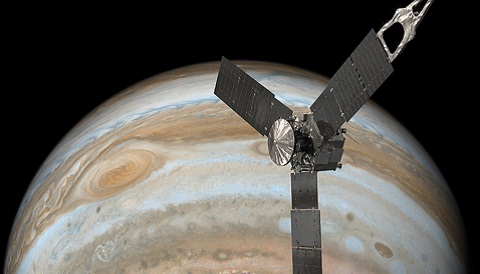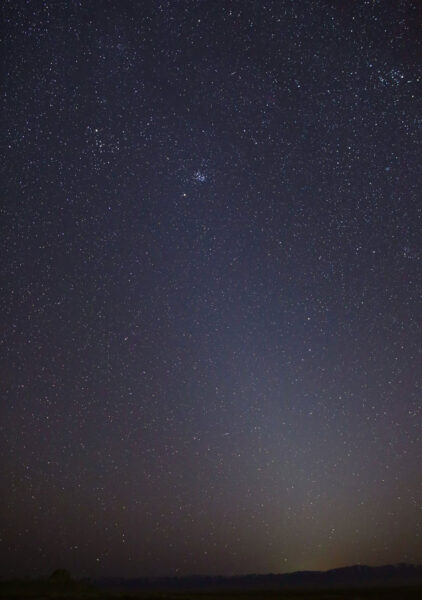15.03.2021
Much of the solar system’s interplanetary dust — seen as zodial light from Earth — might come from Mars, according to a new study.

A Danish-American group of researchers say measurements of the dust’s distribution in the inner solar system suggest the particles have a Martian origin. But others are skeptical, partly because it’s not clear how so much material could escape the Red Planet’s gravity.
The particles are between 1 and 100 microns, roughly the range of the thickness of a human hair. Under ideal conditions, this sunlight-reflecting dust is visible from Earth as the zodiacal light: a triangular glow along the ecliptic, most prominent just after dusk in the west or just before dawn in the east.
Asteroid collisions and cometary fragmentation are generally considered the main sources of zodiacal dust. But a serendipitous find by NASA’s Juno space probe now appears to turn this idea on its head.
JUNO MAPS DUST . . . USING ITS SOLAR PANELS

NASA / JPL-Caltech
On its way to its distant target, Jupiter, Juno first traveled all the way into the asteroid belt, than back to Earth for a gravity assist, and finally outward again. While touring the region between Earth’s orbit and the asteroid belt, Juno’s star tracker cameras — designed by John Leif Jørgensen (Technical University of Denmark) — caught mysterious streaks of light. Detailed analysis revealed they were submillimeter-size pieces of debris, chipped off from the spacecraft as microscopic dust grains slammed into the backside of Juno’s giant solar arrays at a few kilometers per second.
By tallying the number of micro-impacts, Jørgensen and his colleagues were able to, for the first time ever, reconstruct how much zodiacal dust there is at various distances from the Sun. They published the results in Journal of Geophysical Research: Planets. “It’s a fascinating paper,” comments meteorite researcher Peter Jenniskens (SETI Institute).
Stanley Dermott (University of Florida) says he is “excited to realize that these large solar panels may be the best interplanetary dust detectors available. They may open up a new window of solar system exploration.” Indeed, most dedicated dust detectors flown so far are quite small and only capture the much more numerous sub-micron particles. Juno’s huge solar arrays (totaling 60 square meters) are large enough to catch larger zodiacal grains.
DUST FROM MARS
Based on the Juno data, the authors conclude that the zodiacal dust particles orbit the Sun on circular tracks. “We find absolutely no dust outside the 4:1 mean orbital resonance with Jupiter, but lots of it just inside,” says Jørgensen. This resonance is located at 2.065 astronomical units from the Sun, where an object completes four orbits in the same time it takes Jupiter to revolve around the Sun once.
“The only credible explanation is that the dust is trapped inside the 4:1 resonance, so the orbits must be close to circular,” Jørgensen explains.
If colliding asteroids or disintegrating comets were to blame, scientists would expect zodiacal dust particles to have elongated orbits, and Juno should also have measured dust beyond the resonance. Moreover, the team’s calculations, assuming a Mars origin, neatly reproduce the band-like dust features above and below the ecliptic plane first observed in the 1980s by the Infrared Astronomical Satellite.

NASA / JPL-Caltech
Dermott, whose earlier work attributed these dust bands to various asteroid families, is not convinced by the arguments.
“Could [the zodiacal dust] come from Mars? Possibly, but the authors do not explain how the dust leaves Mars,” he says. “We are not talking about one event, but about a source that is active for millions of years.” In their paper, Jørgensen and his colleagues briefly consider dust ejection from Phobos instead, but even then, they admit, it’s hard to see how the dust could escape the Martian system.
Jenniskens has doubts, too. However, he says, “Mapping out the radial distribution of the zodiacal dust, as has now been done for the first time by Juno, will certainly help to eventually identify its source.”
Quelle: Sky&Telescope
